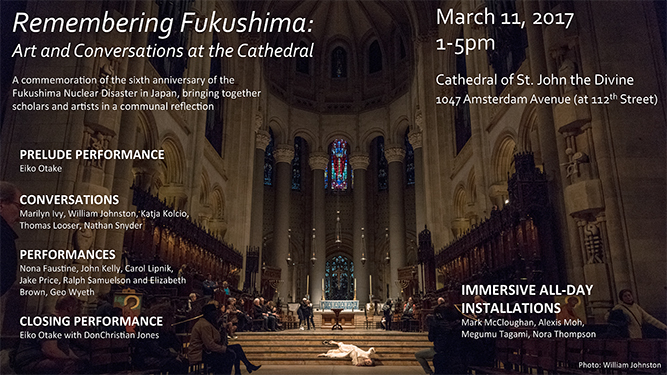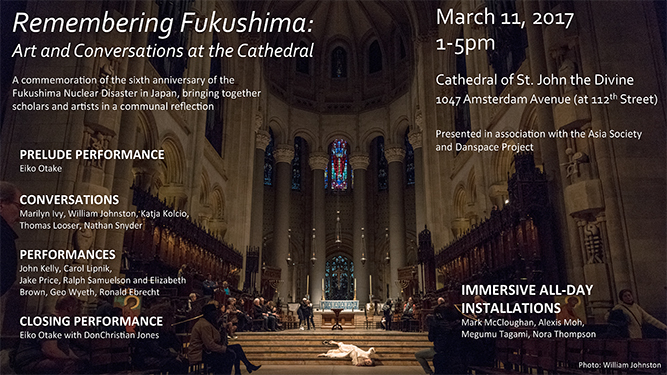Otake, Johnston ‘Fukushima’ Project Culminating Events in NYC on March 11

Eiko Otake stands on the top of a breakwater in a dark gray kimono. To her right, the ocean crashes into piles of concrete cubes–their shapes, stacked together, seem almost too clean, like abstractions of stone. She clutches a large but frayed scarlet cloth that catches the wind and encircles her, hovering just inches from her skin. Following the breakwater into the distance, a large cubic structure is visible along the water’s edge. It is the Fukushima Daini Nuclear Plant, 12 miles from the Fukushima Daiichi Nuclear Plant. She is standing at the midpoint between the infamous two, in the area where the tsunami wave reached 68 feet and the level of radiation remains very high.
Tableaux like this constitute A Body in Fukushima (2016), a series of photographs by Otake, visiting artist in dance and the College of East Asian Studies, and her collaborator William Johnston, professor of history, East Asian studies, science in society and environmental studies. The series shows her, a lone body in the landscape of Fukushima, Japan, in the aftermath of the 2011 Tōhoku earthquake and tsunami. This collaborative photo exhibition had been on Wesleyan’s campus from February through May 2015.
Currently in New York City as part of The Christa Project: Manifesting Diving Bodies, at the Cathedral Church of St. John the Divine, the exhibit will culminate in Remembering Fukushima: Art and Conversations at the Cathedral on March 11, the sixth anniversary of the earthquake, tsunami and nuclear meltdowns that followed.
A collection of speakers, musicians and artists, many of whom are Wesleyan alumni, will participate. Artists, performers, and those facilitating reflections on Fukushima and its legacy include Wesleyan Artist in Residence and University Organist Ronald Ebrecht, Ralph Samuelson MA ’71, Shin Otake ’10, Megu Tagami ’10, DonChristian Jones ’12, Nora Thompson ’15, and Hannah Wolfe Eisner ’17, who is co-curator of The Christa Project at the cathedral. Professor of Dance Katja Kolcio will be one of the professors participating in a conversation on nuclear issues and how these have affected their teaching. Otake also cites dramaturge Mark McCloughan ’10 and media coordinator Alexis Moh ’15, who will be showing their art, including Moh’s new video installation—a reflection on her time at Standing Rock.
This project had its inception in an unlikely place—a train station. In October of 2014, Otake was performing her first solo project A Body in Places, a 12-hour performance piece, at the 30th Street Amtrak station in Philadelphia. Previously she had visited the deserted train stations in Fukushima in 2011 after the triple disaster—and she was inspired. “The next thing to do,” reported Otake, “was to call Bill Johnston.” He was an ideal collaborator: the two had previously taught a course on the atomic bomb together and he has expertise in issues of Japanese public health.
Johnston and Otake twice visited Fukushima for their first photoshoots in 2014, delving into evacuated spaces. The result was shown as the three-gallery exhibition at Wesleyan in 2015. Upon returning for their 2016 iteration of A Body in Fukushima, the two further explored abandoned areas—the deserted woodlands and silent shrines of Fukushima.
Forests remain some of the few spaces left untouched within the vicinity of the Fukushima Daiichi Nuclear Reactor, she says. The rest—fields, roads and houses—have been bulldozed by workers in an attempt to decontaminate—so the areas that appear pristine are actually those that harbor the greater levels of radioactivity.
“We are going through such a hard time politically that I am afraid the name ‘Fukushima’ is not in many people’s minds these days,” Otake says, “but I want Fukushima to remain a concern, especially now. The Fukushima meltdowns were the worst nuclear accidents since Chernobyl, and contamination of the surrounding areas continues. Professor Johnston and I witnessed another layer of human negligence when we returned to Fukushima this summer. We cannot ask people to remember something they have little knowledge about or familiarity with, so I want to offer a time and space in which a wide range of people can have a firsthand experience, connect and create a new memory regarding nuclear matters.”
Otake struggled with this issue of exposure during her trips to Fukushima. She confesses, “‘I took off my shoes and had a moment of hesitation, ‘This is high radiation and I am barefoot.’ But I had to be barefoot. Many months later I still ask myself the same question and keep realizing I HAD TO be barefoot to be connected to the land.”


